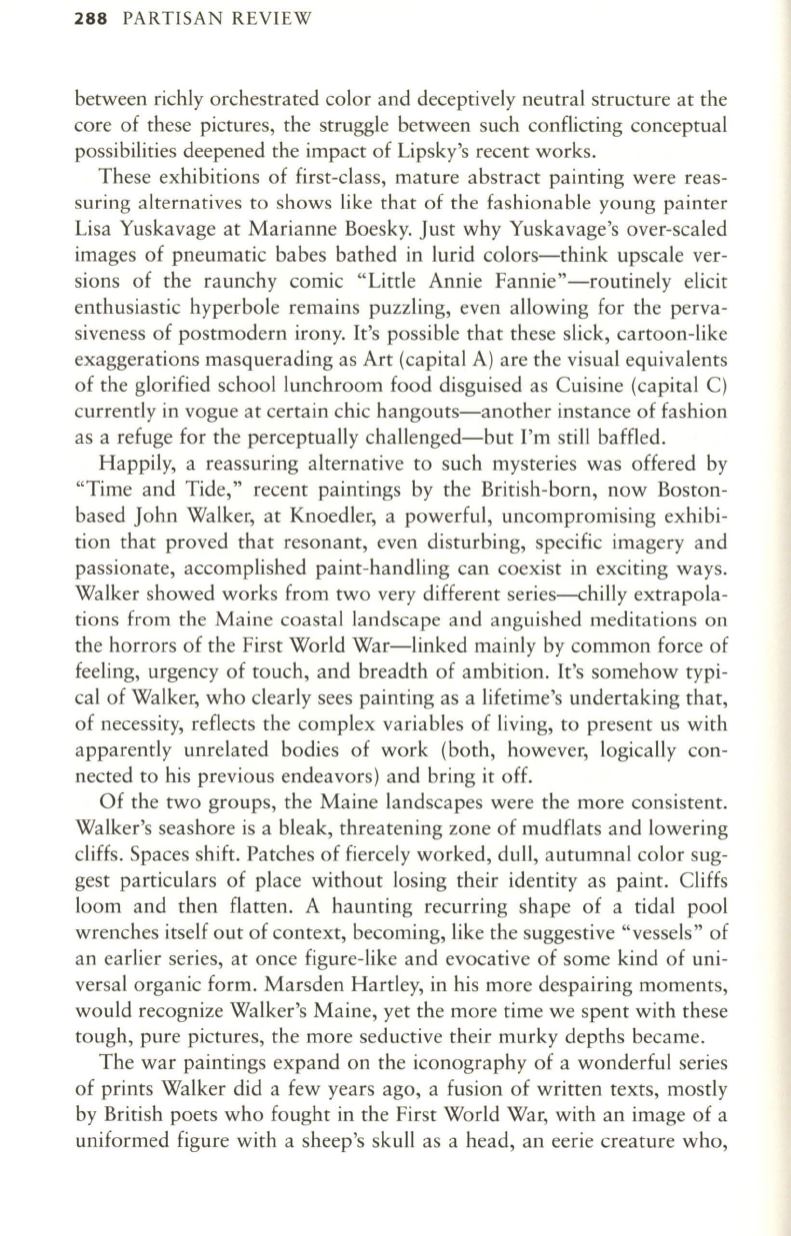
288
PARTISAN REVIEW
between richly orchestrated color and deceptively neutral structure at the
core of these pictures, the struggle between such conflicting conceptual
possibilities deepened the impact of Lipsky's recent works.
These exhibitions of first-class, mature abstract painting were reas–
suring alternatives to shows like that of the fashionable young painter
Lisa Yuskavage at Marianne Boesky. Just why Yuskavage's over-scaled
images of pneumatic babes bathed in lurid colors-think upscale ver–
sions of the raunchy comic "Little Annie Fannie"-routinely elicit
enthusiastic hyperbole remains puzzling, even allowing for the perva–
siveness of postmodern irony. It's possible that these slick, cartoon-like
exaggerations masquerading as Art (capital A) are the visual equivalents
of the glorified school lunchroom food disguised as Cuisine (capital
C)
currently in vogue at certain chic hangouts-another instance of fashion
as a refuge for the perceptually challenged-but I'm still baffled.
Happily, a reassuring alternative to such mysteries was offered by
"Time and Tide," recent paintings by the British-born, now Boston–
based John Walker, at Knoedler, a powerful, uncompromising exhibi–
tion that proved that resonant, even disturbing, specific imagery and
passionate, accomplished paint-handling can coexist in exciting ways.
Walker showed works from two very different series-chilly extrapola–
tions from the Maine coastal landscape and anguished meditations on
the horrors of the First World War-linked mainly by common force of
feeling, urgency of touch, and breadth of ambition. It's somehow typi–
cal of Walker, who clearly sees painting as a lifetime's undertaking that,
of necessity, reflects the complex variables of living, to present us with
apparently unrelated bodies of work (both, however, logically con–
nected to his previous endeavors) and bring it off.
Of the two groups, the Maine landscapes were the more consistent.
Walker's seashore is a bleak, threatening zone of mudflats and lowering
cliffs. Spaces shift. Patches of fiercely worked, dull, autumnal color sug–
gest particulars of place without losing their identity as paint. Cliffs
loom and then flatten . A haunting recurring shape of a tidal pool
wrenches itself out of context, becoming, like the suggestive "vessels" of
an earlier series, at once figure-like and evocative of some kind of uni–
versal organic form. Marsden Hartley, in his more despairing moments,
would recognize Walker's Maine, yet the more time we spent with these
tough, pure pictures, the more seductive their murky depths became.
The war paintings expand on the iconography of a wonderful series
of prints Walker did a few years ago, a fusion of written texts, mostly
by British poets who fought in the First World War, with an image of a
uniformed figure with a sheep's skull as a head, an eerie creature who,


